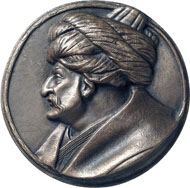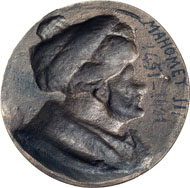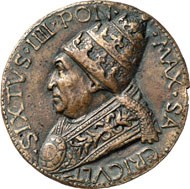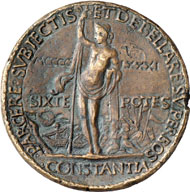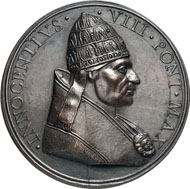by courtesy of Gorny & Mosch
On May 3, 1481 died Mehmed II called the Conqueror, who once had conquered Constantinople. Behind, he left two sons, Bayezid aged 16 whose mother was a Christian-Albanese slave, and Cem, born after Mehmed’s ascension to the throne. Who of them would be Mehmed’s heir as sultan? Bayezid who stayed in Amasia, the traditional residence of the Ottoman successor to the throne? Or his younger brother Cem, acting governor in Konya?
Bayezid was deeply religious with a certain inclination to mysticism. Hence he was completely supported by the Sunnite clergy and the large landowners aware of tradition. Cem, on the other hand, was a pragmatist, beloved by the army, and the grand vizier’s favorite. No wonder the latter tried to pass the news of the sultan’s death to Cem before his older brother and antagonist might hear about it. But Bayezid’s followers intercepted the messenger, the grand vizier was executed consequently. Thus as early as May 20, 1481 the older brother reached Constantinople assuming power.
Mehmed II the Conqueror (1451-1481). Uniface bronze medal from the 19th century. From Dogan Collection, Auction Gorny & Mosch 172 (2008), 6009.
However, for a short period Cem was able to build up a powerbase in Minor Asia. At this time he even issued coins which today are a wanted rarity. But although he even conquered Bursa temporarily, he failed to match up to the united forces of the mighty Ottoman ruler. Thus he was forced to take flight. In this moment the Knights of St John in Rhodes, the arch-enemy of the Ottoman Empire, offered him cover and support.
Of course they had reasons of their own for that action: What an opportunity to have a popular Ottoman prince up one’s sleeve, hence a man who one might establish as an alternative to the ruling sultan! Thus the pious knights were paid dearly for holding Cem prisoner in their Savoy Commandry.
However, other rulers showed interest in the prince, too: Hungary’s King Matthias Corvinus was eager to conduct Cem on a campaign against the Turks in order to cause the Ottoman troops to desert to him. Also the French King and especially the Pope wanted Cem. After all the Pope had just succeeded in driving the Turk army out of Italy.
Sixtus IV (Pope 1471-1484). 1481 bronze medal by Andrea Guazzalotti in occasion of Italy’s liberation from the Turks. From Dogan Collection, Auction Gorny & Mosch 172 (2008), 6014.
In the spring of 1480 Turk troops finally conquered Otranto. Mehmed considered himself ‘heir’ of the Byzantine Emperor and thus laid claim to southern Italy, former part of the Byzantine Empire. However, Alfonso II, son and subsequent successor to Ferdinand I of Aragon, King of Naples, retook the city in 1481. He had not even to apply force since the Ottoman troops were too glad to hand over the city to the Christian army in exchange for being granted a safe conduct.
Finally the Pope sewed this match up. He was handed over Cem in order to use him to the benefit of a crusade of all Christian realms against the Ottoman Empire.
Innocent VIII (Pope 1484-1492). Bronze medal, no year (die after 1664 by G. Paladino). Rv. Cem prostrating himself in front of Innocent on the throne. Restrike from the 19th century. From Dogan Collection, Auction Gorny & Mosch 172 (2008), 6015.
While the Christian powers were jockeying for the Ottoman Prince, he capitulated. With hashish and excessive amount of food Cem tried to escape from reality. Adipose and indifferent he consented to be hauled from one prison to another. Who knows how much he understood of all that was happening around him? What did he notice when Alexander VI negotiated with Bayezid, but later ceded Cem to Charles VIII, King of France, who marched to Italy in 1494 in order to conquer the Kingdom of Naples. It was there where Cem died, probably poisoned.
His half-brother Bayezid although residing in Istanbul was always very well informed about Cem’s vicissitudes. Actually he maintained an extremely effective spy network in Europe to be constantly in the loop. Among these spies were a Greek monk, a professional spy named Antoni, Andreas Mila, a merchant from Pera, and Gaspar Grimaldo, a powerful man from Genova who might even have been involved into Cem’s removal.
The Grand Master of the Knights Hospitaller hosts the Turk prince Cem.
Although in the end Cem was dead, not even this fact did concede him peace. Charles VIII demanded 5,000 ducats from Bayezid in exchange for the prince’s body. Bayezid answered by sending a whole fleet against Naples. In order to avoid war, he was handed over the coffin subsequently. Bayezid transferred it then to Bursa where Cem found his final resting place.



